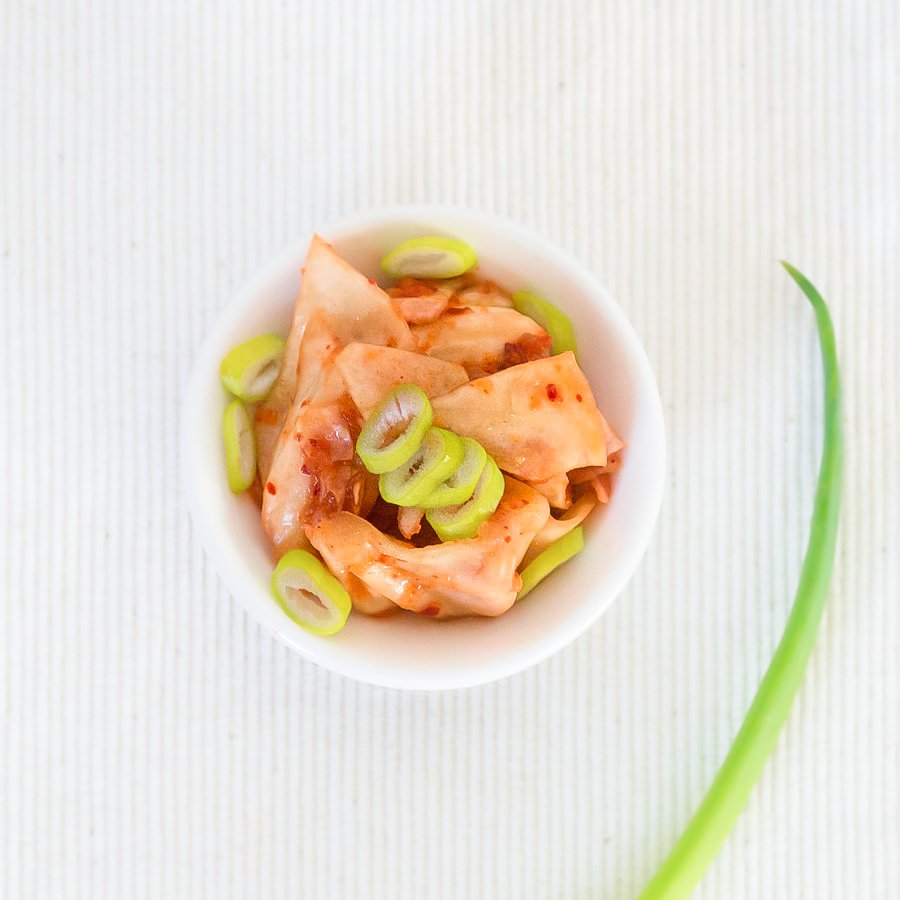Kimchi
Traditionally in Korea and like most pickles, it is usually prepared in large quantities. This recipe has the measure approx. of two bottles of 500gr. The original recipe is made with napa cabbage, however, we used regular white cabbage. But, you can use any cabbage, savoy, white, or even kale, carrots, bok choi... radishes?. We'll try next time.
Ingredients:
1/2 large white cabbage, cut in the way you prefer. Wedo chunk of 3-4cm.
Salty water: 1/4 cup of salt for 6 cups of water
........
The paste:
1 red apple, roughly chopped
1 small onion, peeled and roughly chopped
1 thumb of ginger
2-3 garlic cloves
3 Tbsp of Korean chili flakes or powder (Gochugaru)
4-6 stalks of spring onions
Process:
- Place chopped cabbage in a large bowl and cover it with salty water. Cabbage should be fully submerged. To help you do this, place a plate that fits inside the bowl, and then put something heavy on top of the plate. Let the cabbage rest with the salt for several hours or overnight.
- In a food processor add the apple, onion, ginger, and garlic. Blend until you get a puré.
- Mix the puré, the Korean chili and spring onions with a spoon or spatula, not in the processor.
- Drain the cabbage well and rinse it
- Toss the cabbage with the paste.
- Pack the kimchi into the jar. Begin placing the coated cabbage in the container, packing down to ensure there is as little air as possible between leaves. Continue until all cabbage is packed in, then press down very firmly to remove air. Top with a clean, sterilized lid, and set in a cool dark place (such as a cabinet, not the refrigerator) to ferment.
- How long to ferment is up to you. Between 2 - 5 days, should do the work. The longer you ferment the kimchi, the tangier and intense the flavor will be, and the more tender the cabbage will become.
- Check the kimchi once a day, opening the jar and pressing down on the vegetables with a clean finger or spoon to keep them submerged under its own brine.
- A good indicator of when it’s done fermenting is the smell. If it smells pleasant to the nose and tangy, like the kimchi you’re used to trying, it’s probably ready to transfer to the refrigerator. Kimchi will keep in the refrigerator for at least 3-4 weeks, and even months.
History:
Samguk Sagi (r. 1122-1146), a historical record of the Three Kingdoms of Korea, also mentions the pickle jar used to ferment vegetables, which indicates that fermented vegetables were commonly eaten during this time. During the Silla dynasty (57 BC – AD 935), kimchi became prevalent as Buddhism caught on throughout the nation and fostered a vegetarian lifestyle.
The pickling of vegetables was an ideal method, prior to refrigerators, that helped to preserve the lifespan of foods. In Korea, kimchi was made during the winter by fermenting vegetables, and burying them in the ground in traditional brown ceramic pots called onggi. This labor further allowed bonding among women within the family. A poem on Korean radish written by Yi Gyubo, a 13th-century literatus, shows that radish kimchi was a commonplace in Goryeo (918–1392).
Pickled radish slices make a good summer side-dish,
Radish preserved in salt is a winter side-dish from start to end.
The roots in the earth grow plumper every day,
Harvesting after the frost, a slice cut by a knife tastes like a pear.
— Yi Gyubo, Donggukisanggukjip

